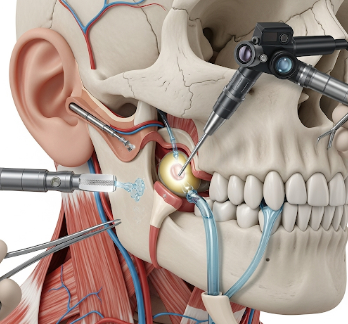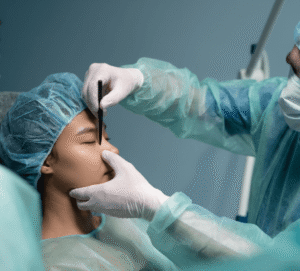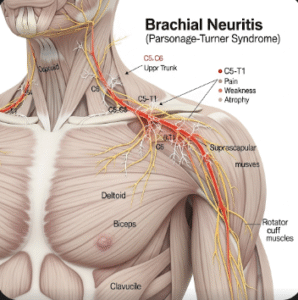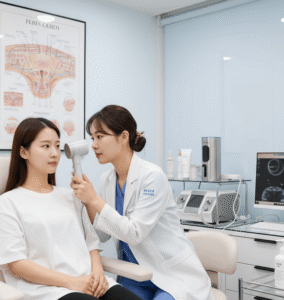Overview
TMJ arthroscopy is a minimally invasive surgical procedure used to diagnose and treat disorders of the temporomandibular joint (TMJ), the joint connecting the jawbone to the skull. It allows doctors to visualize the joint, remove adhesions, treat inflammation, and perform minor surgical repairs without open surgery.
In Korea, TMJ arthroscopy is performed in advanced maxillofacial and dental surgery centers using high-definition endoscopic equipment, ensuring precise treatment, minimal discomfort, and rapid recovery.
What is TMJ Arthroscopy?
TMJ arthroscopy is a procedure where a small camera (arthroscope) and surgical instruments are inserted into the TMJ through tiny incisions.
Key applications include:
- ✦ Diagnosis of TMJ disorders: internal derangement, joint inflammation, or degenerative changes.
- ➤ Therapeutic procedures: removal of adhesions, lavage, injection of medications, or minor tissue repair.
- ✦ Minimally invasive alternative to open TMJ surgery.
- ➤ Precise visualization of joint structures for accurate treatment.
The procedure helps alleviate jaw pain, improve joint function, and prevent progression of joint disorders.
What are the Benefits?
TMJ arthroscopy provides multiple advantages:
✅ Minimally invasive with small incisions.
➤ Short procedure time: typically 30–60 minutes.
✦ Rapid recovery compared to open TMJ surgery.
➤ Direct treatment of joint inflammation, adhesions, or minor injuries.
✅ Reduces pain and improves jaw function.
✦ Minimally visible scarring and lower risk of complications.
Procedure Details
1) How should I prepare for TMJ Arthroscopy?
Preparation includes:
- ✦ Medical evaluation: review health history, medications, allergies, and prior jaw surgeries.
- ➤ Imaging: MRI or CT scan to assess joint structures and plan treatment.
- ✦ Laboratory tests: blood tests if sedation or general anesthesia is planned.
- ➤ Medication adjustments: discontinue anticoagulants if advised.
- ✦ Consent and counseling: discuss procedure steps, risks, benefits, and recovery expectations.
- ➤ Fasting instructions: typically 6–8 hours before sedation or general anesthesia.
2) What happens during the procedure TMJ Arthroscopy?
TMJ arthroscopy is usually performed under local anesthesia with sedation or general anesthesia:
➤ Step 1: Small incisions (1–2 mm) made near the TMJ.
✦ Step 2: Arthroscope inserted into the joint, providing high-definition visualization.
➤ Step 3: Saline is used to expand the joint space and flush debris.
✦ Step 4: Surgical instruments may remove adhesions, inflamed tissue, or perform minor repairs.
➤ Step 5: Medication such as corticosteroids may be injected to reduce inflammation.
✦ Step 6: Incisions closed with tiny sutures; sterile dressing applied.
Korean centers utilize advanced arthroscopic systems to minimize trauma and maximize treatment precision.
3) What happens after TMJ Arthroscopy?
Postoperative care includes:
- ✦ Monitoring: vital signs and initial jaw function.
- ➤ Pain management: mild analgesics for discomfort.
- ✦ Jaw care: soft diet for several days and avoidance of excessive jaw movement.
- ➤ Physiotherapy: gentle exercises to restore jaw mobility and strength.
- ✦ Follow-up: assessment of pain relief, joint movement, and healing of incision sites.
- ➤ Long-term outlook: improved jaw function, reduced pain, and decreased risk of further TMJ deterioration.
Recovery is typically rapid, with most patients resuming normal activities within 3–7 days, and full functional recovery within 2–4 weeks.
Risks / Benefits
Potential Risks:
- ✦ Temporary swelling, bruising, or mild jaw discomfort.
- ➤ Infection at incision sites (rare).
- ✦ Bleeding or hematoma formation (very rare).
- ➤ Temporary nerve irritation causing numbness around the jaw or ear.
- ✦ Rare complications: joint stiffness or persistent pain.
Benefits:
- ✅ Minimally invasive with short recovery time.
- ✅ Direct treatment of TMJ disorders with high accuracy.
- ✅ Reduces pain and restores joint function.
- ✅ Low risk of complications compared to open TMJ surgery.
- ✅ Excellent cosmetic results with minimal scarring.
Recovery and Outlook
Recovery after TMJ arthroscopy generally includes:
- ➤ Immediate care: pain control and monitoring for swelling.
- ✦ Activity: soft diet and avoidance of jaw strain for 1–2 weeks.
- ➤ Physiotherapy: exercises to improve jaw range of motion and strength.
- ✦ Follow-up: regular evaluation to ensure optimal joint healing and function.
- ➤ Long-term outcome: most patients experience significant pain relief, improved jaw mobility, and prevention of progressive joint disorders.
When To Call the Doctor
Contact your healthcare provider if you notice:
⚠ Persistent or worsening jaw pain.
⚠ Swelling, redness, or discharge at incision sites.
⚠ Difficulty opening or closing the mouth.
⚠ Numbness or tingling around the jaw or ear.
⚠ Fever or signs of infection.
Best Korea Option / Process
Korea provides world-class TMJ arthroscopy with:
- ✦ Experienced maxillofacial surgeons skilled in arthroscopic and minimally invasive TMJ techniques.
- ➤ High-definition arthroscopic equipment for precise visualization and treatment.
- ✦ Minimally invasive procedure with rapid recovery and minimal scarring.
- ➤ Comprehensive pre- and post-operative care, including physiotherapy and follow-up.
- ✦ Safe and effective procedures for domestic and international patients.
- ➤ Multidisciplinary approach ensures pain relief, restored jaw function, and optimal cosmetic outcomes.
Korean centers ensure patients receive precise, safe, and effective TMJ treatment with minimal complications and excellent recovery.
Highlights of TMJ Arthroscopy in Korea
- ✅ Minimally invasive procedure for TMJ disorders.
- ➤ Direct visualization and targeted treatment of joint problems.
- ✦ Short procedure time and rapid recovery.
- ➤ Minimal scarring and low complication rates.
- ✅ Expert pre- and post-operative care in advanced Korean centers.













